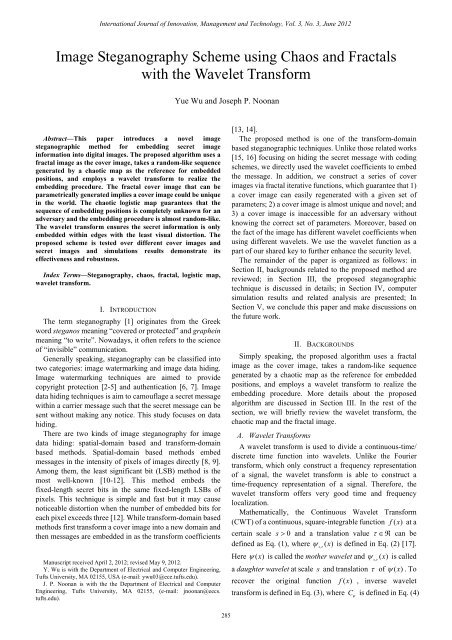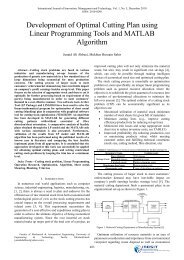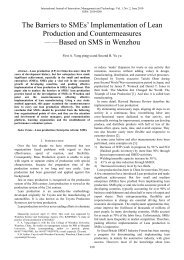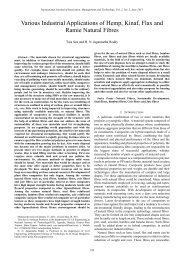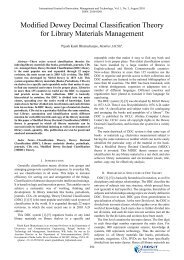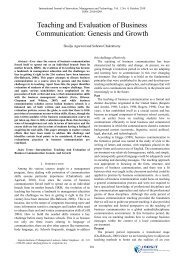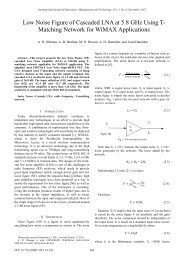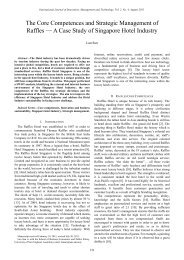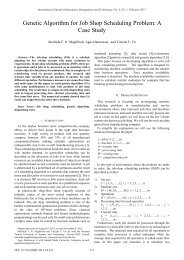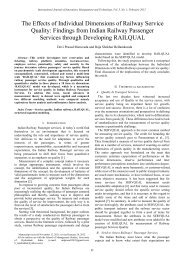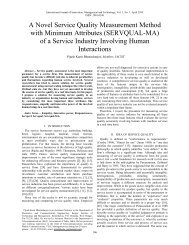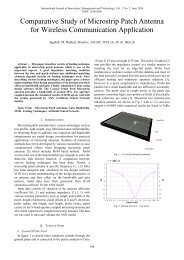Image Steganography Scheme using Chaos and Fractals with ... - ijimt
Image Steganography Scheme using Chaos and Fractals with ... - ijimt
Image Steganography Scheme using Chaos and Fractals with ... - ijimt
You also want an ePaper? Increase the reach of your titles
YUMPU automatically turns print PDFs into web optimized ePapers that Google loves.
International Journal of Innovation, Management <strong>and</strong> Technology, Vol. 3, No. 3, June 2012<br />
<strong>Image</strong> <strong>Steganography</strong> <strong>Scheme</strong> <strong>using</strong> <strong>Chaos</strong> <strong>and</strong> <strong>Fractals</strong><br />
<strong>with</strong> the Wavelet Transform<br />
Yue Wu <strong>and</strong> Joseph P. Noonan<br />
Abstract—This paper introduces a novel image<br />
steganographic method for embedding secret image<br />
information into digital images. The proposed algorithm uses a<br />
fractal image as the cover image, takes a r<strong>and</strong>om-like sequence<br />
generated by a chaotic map as the reference for embedded<br />
positions, <strong>and</strong> employs a wavelet transform to realize the<br />
embedding procedure. The fractal cover image that can be<br />
parametrically generated implies a cover image could be unique<br />
in the world. The chaotic logistic map guarantees that the<br />
sequence of embedding positions is completely unknown for an<br />
adversary <strong>and</strong> the embedding procedure is almost r<strong>and</strong>om-like.<br />
The wavelet transform ensures the secret information is only<br />
embedded <strong>with</strong>in edges <strong>with</strong> the least visual distortion. The<br />
proposed scheme is tested over different cover images <strong>and</strong><br />
secret images <strong>and</strong> simulations results demonstrate its<br />
effectiveness <strong>and</strong> robustness.<br />
Index Terms—<strong>Steganography</strong>, chaos, fractal, logistic map,<br />
wavelet transform.<br />
I. INTRODUCTION<br />
The term steganography [1] originates from the Greek<br />
word steganos meaning “covered or protected” <strong>and</strong> graphein<br />
meaning “to write”. Nowadays, it often refers to the science<br />
of “invisible” communication.<br />
Generally speaking, steganography can be classified into<br />
two categories: image watermarking <strong>and</strong> image data hiding.<br />
<strong>Image</strong> watermarking techniques are aimed to provide<br />
copyright protection [2-5] <strong>and</strong> authentication [6, 7]. <strong>Image</strong><br />
data hiding techniques is aim to camouflage a secret message<br />
<strong>with</strong>in a carrier message such that the secret message can be<br />
sent <strong>with</strong>out making any notice. This study focuses on data<br />
hiding.<br />
There are two kinds of image steganography for image<br />
data hiding: spatial-domain based <strong>and</strong> transform-domain<br />
based methods. Spatial-domain based methods embed<br />
messages in the intensity of pixels of images directly [8, 9].<br />
Among them, the least significant bit (LSB) method is the<br />
most well-known [10-12]. This method embeds the<br />
fixed-length secret bits in the same fixed-length LSBs of<br />
pixels. This technique is simple <strong>and</strong> fast but it may cause<br />
noticeable distortion when the number of embedded bits for<br />
each pixel exceeds three [12]. While transform-domain based<br />
methods first transform a cover image into a new domain <strong>and</strong><br />
then messages are embedded in as the transform coefficients<br />
Manuscript received April 2, 2012; revised May 9, 2012.<br />
Y. Wu is <strong>with</strong> the Department of Electrical <strong>and</strong> Computer Engineering,<br />
Tufts University, MA 02155, USA (e-mail: ywu03@ece.tufts.edu).<br />
J. P. Noonan is <strong>with</strong> the the Department of Electrical <strong>and</strong> Computer<br />
Engineering, Tufts University, MA 02155, (e-mail: jnoonan@eecs.<br />
tufts.edu).<br />
[13, 14].<br />
The proposed method is one of the transform-domain<br />
based steganographic techniques. Unlike those related works<br />
[15, 16] foc<strong>using</strong> on hiding the secret message <strong>with</strong> coding<br />
schemes, we directly used the wavelet coefficients to embed<br />
the message. In addition, we construct a series of cover<br />
images via fractal iterative functions, which guarantee that 1)<br />
a cover image can easily regenerated <strong>with</strong> a given set of<br />
parameters; 2) a cover image is almost unique <strong>and</strong> novel; <strong>and</strong><br />
3) a cover image is inaccessible for an adversary <strong>with</strong>out<br />
knowing the correct set of parameters. Moreover, based on<br />
the fact of the image has different wavelet coefficients when<br />
<strong>using</strong> different wavelets. We use the wavelet function as a<br />
part of our shared key to further enhance the security level.<br />
The remainder of the paper is organized as follows: in<br />
Section II, backgrounds related to the proposed method are<br />
reviewed; in Section III, the proposed steganographic<br />
technique is discussed in details; in Section IV, computer<br />
simulation results <strong>and</strong> related analysis are presented; In<br />
Section V, we conclude this paper <strong>and</strong> make discussions on<br />
the future work.<br />
II. BACKGROUNDS<br />
Simply speaking, the proposed algorithm uses a fractal<br />
image as the cover image, takes a r<strong>and</strong>om-like sequence<br />
generated by a chaotic map as the reference for embedded<br />
positions, <strong>and</strong> employs a wavelet transform to realize the<br />
embedding procedure. More details about the proposed<br />
algorithm are discussed in Section III. In the rest of the<br />
section, we will briefly review the wavelet transform, the<br />
chaotic map <strong>and</strong> the fractal image.<br />
A. Wavelet Transforms<br />
A wavelet transform is used to divide a continuous-time/<br />
discrete time function into wavelets. Unlike the Fourier<br />
transform, which only construct a frequency representation<br />
of a signal, the wavelet transform is able to construct a<br />
time-frequency representation of a signal. Therefore, the<br />
wavelet transform offers very good time <strong>and</strong> frequency<br />
localization.<br />
Mathematically, the Continuous Wavelet Transform<br />
(CWT) of a continuous, square-integrable function f ( x ) at a<br />
certain scale s > 0 <strong>and</strong> a translation value τ ∈R can be<br />
defined as Eq. (1), where ψ ( x)<br />
is defined in Eq. (2) [17].<br />
s, τ<br />
Here ψ ( x)<br />
is called the mother wavelet <strong>and</strong> ψ ( x)<br />
is called<br />
s, τ<br />
a daughter wavelet at scale s <strong>and</strong> translation τ of ψ ( x)<br />
. To<br />
recover the original function f ( x ) , inverse wavelet<br />
transform is defined in Eq. (3), where C ψ<br />
is defined in Eq. (4)<br />
285
International Journal of Innovation, Management <strong>and</strong> Technology, Vol. 3, No. 3, June 2012<br />
<strong>and</strong> Ψ ( μ)<br />
is the Fourier transform of ψ ( x)<br />
. Eqs. (1) to (4)<br />
define a reversible transformation as long as the so-callled<br />
admissibility criterion C ψ<br />
International Journal of Innovation, Management <strong>and</strong> Technology, Vol. 3, No. 3, June 2012<br />
<strong>and</strong> W ( I ).<br />
Here W <strong>and</strong> W are determined by the key <strong>and</strong><br />
2 1<br />
2<br />
they may or may not be necessarily the same. One benefit of<br />
this design is to achieve a larger key space. Unless the correct<br />
wavelet mother function W is used, one cannot extract the<br />
1<br />
exact embedded secret information from a cover image;<br />
unless the correct wavelet mother function W is used, one<br />
2<br />
cannot restore the secret information from extracted secret<br />
information in the spatial domain.<br />
Stage I<br />
Stage II<br />
A<br />
DV<br />
Secret<br />
<strong>Image</strong> Ι<br />
W(Ι)<br />
A<br />
DV<br />
DWT<br />
W(SCb)<br />
DH<br />
DD<br />
DH<br />
DD<br />
Logistic<br />
Map<br />
Selecting<br />
Positions<br />
Energy<br />
Equalization<br />
Embedding Data<br />
IDWT<br />
Stage III<br />
W(CCb)<br />
SCb<br />
A<br />
DV<br />
DWT<br />
DH<br />
DD<br />
IYCbCr<br />
CCb<br />
Cover<br />
<strong>Image</strong> C<br />
YCbCr<br />
CCr<br />
CY<br />
Stego<br />
<strong>Image</strong> S<br />
Fig. 2. The flowchart of the proposed steganographic scheme.<br />
B. Stage II: Secret Data Embedding<br />
This stage is the core of the steganography. It embeds the<br />
transformed secret image W 2<br />
( I ) in the transformed cover<br />
image W ( C ) .<br />
1 Cb<br />
First, the initial value x <strong>and</strong> the parameter value r of the<br />
0<br />
logistic map in Eq. (9) are determined by the key. Based on<br />
the number of coefficients in W 2<br />
( I ) , the logistic map<br />
generates an equal length chaotic sequence Seq. However,<br />
this sequence Seq has to be quantized before used for<br />
extracting wavelet coefficients in W ( C ) . The number of<br />
1 Cb<br />
quantization scales N is calculated via Eq. (10), where<br />
#(.) computes the number of elements <strong>and</strong> dt . rounds the<br />
number towards to zero. Then Seq is quantized <strong>with</strong> respect<br />
to the bin numbers of the N equal-length bins in (0,1) ,<br />
namely<br />
⎛ 1 ⎤ ⎛k−1 k ⎤ ⎛ N −1<br />
⎞<br />
B = 0, , , B , , , B ,1<br />
1 ⎜ k<br />
N<br />
N<br />
⎥ = ⎜ =<br />
N N<br />
⎥ ⎜<br />
N<br />
⎟<br />
⎝ ⎦ ⎝ ⎦ <br />
⎝ ⎠<br />
Consequently, Seq is translated to a r<strong>and</strong>om-like sequence<br />
Seq composed of only numbers from 1 to N .<br />
N<br />
However Seq is still not the sequence which can be used<br />
N<br />
to extract wavelet coefficient in W ( C ) . Seq is calculated<br />
1 Cb<br />
N<br />
for partial sum <strong>and</strong> the Seq is obtained according to Eq. (11).<br />
c<br />
Seq is used to extract wavelet coefficients in W ( C ) . It is<br />
c<br />
1 Cb<br />
worthwhile to note that W ( C ) is composed of four regions<br />
1 Cb<br />
(see Fig. 2), namely approximation region A (passed by the<br />
low-pass filter along y <strong>and</strong> followed by the low-pass filter<br />
along x ), horizontal-details region DH(passed by the<br />
low-pass filter along y <strong>and</strong> followed by the high-pass filter<br />
along x ), vertical-details region VH(passed by the high-pass<br />
filter along y <strong>and</strong> followed by the low-pass filter along x ),<br />
<strong>and</strong> diagonal-details DD (passed by the high-pass filter along<br />
y <strong>and</strong> followed by the high-pass filter along x ). We keep<br />
region A but choose to substitute coefficients in DH, DV <strong>and</strong><br />
DD by the wavelet coefficients of W ( I ) . This is the reason<br />
2<br />
why Eq. (10) contains a factor of 3/4. In fact, the region A<br />
can be considered as the DC component of the image C .<br />
Cb<br />
Any change in this DC component may lead to big changes in<br />
the future. However, DH, DV <strong>and</strong> DD are more or less about<br />
the edge strength of C . Fractal cover images normally have<br />
Cb<br />
a large number of edges <strong>and</strong> rely on the DC component of the<br />
image to have the fractal-like patterns.<br />
⎢ 3 × #( C Cb<br />
) ⎥<br />
N = ⎢ ⎥<br />
(10)<br />
⎣ 4 × #( W ( I))<br />
2 ⎦<br />
k<br />
Seq ( k) = ∑ Seq ( k)<br />
(11)<br />
c<br />
i=<br />
1<br />
N<br />
The selected coefficients in W ( C ) are uniquely determined<br />
1 Cb<br />
by Seq <strong>and</strong> we named the set of the chosen coefficients as<br />
c<br />
P . Eq. (12) is used as the ratio of energy in set X to that in<br />
set Y , where E(.)<br />
represents the energy function.<br />
2<br />
EX ( ) x<br />
RXY ( , ) = 2<br />
EY ( )<br />
= ∑<br />
∑ (12)<br />
y<br />
We then compute L = R( P, W ( I))<br />
<strong>and</strong> lift wavelet<br />
2<br />
coefficients correspondingly, Consequently, the lifted energy<br />
LE( W ( I )) approximately match the energy of the original<br />
2<br />
EP ( ). Finally, we call these modified wavelet coefficients<br />
W ( S ) .<br />
1 Cb<br />
C. Stage III: Transforming <strong>Image</strong> Back to Spatial Domain<br />
Parallel to the Stage I, the main task of the Stage III is to<br />
inverse transform everything in the wavelet domain to the<br />
spatial domain.<br />
W ( S ) is inverse wavelet transformed to the spatial<br />
1 Cb<br />
domain <strong>and</strong> becomes the image S Cb<br />
. The S Cb<br />
is used to<br />
replace the original Cb component C Cb<br />
for the color cover<br />
image C .<br />
Eventually, the component set { C , S , C } is converted<br />
Y Cb Cr<br />
from the YCbCr color space to the RGB color space.<br />
IV. SIMULATION RESULTS AND DISCUSSION<br />
Our computer simulation is run in the MATLAB R2009a<br />
environment under Window XP operation system <strong>with</strong> 3GB<br />
memory <strong>and</strong> Core 2 Quad 2.6GHz CPU.<br />
The key we used in the simulation has the format of<br />
{ x , r, width, height, db #, db #}, where x <strong>and</strong> r are used in<br />
0<br />
C I<br />
0<br />
the logistic map for generating the embedding/ extracting<br />
positions; width <strong>and</strong> height are used to reform the rebuilt<br />
287
International Journal of Innovation, Management <strong>and</strong> Technology, Vol. 3, No. 3, June 2012<br />
secret image; db # <strong>and</strong> db #<br />
C<br />
I<br />
refer the used Daubechies<br />
wavelets for the cover/stego image C/<br />
S <strong>and</strong> the secret<br />
image I respectively.<br />
Fig. 3 shows the used cover images for simulation. They<br />
are all generated from Ultra Fractal [20]. The image can be<br />
saved as a parameter file <strong>and</strong> thus can be easily transported<br />
<strong>and</strong> perfectly restored in other computers installed Ultra<br />
Fractal. Here all cover images are at size of 640× 480 .<br />
(a) Leaf<br />
(b) Feather<br />
(c) Fragment<br />
(d) Storm<br />
Fig. 3. The cover image generated by Ultral Fractal.<br />
Fig. 4 shows the test secret images in the simulation. The<br />
image of ‘Tufts Logo’ is of size of 128× 128 while the image<br />
of ‘cameraman’ is at size of 256× 256 .<br />
(PSNR) <strong>and</strong> the root-mean-square error (RMSE) of the<br />
embedding results are two common measurements for<br />
evaluating the quality of reconstructed signal. RMSE is<br />
defined by the Eq. (13), where C <strong>and</strong> S represents the<br />
cover image <strong>and</strong> the stego image respectively; m <strong>and</strong> n<br />
refer to the width <strong>and</strong> height of the image. PSNR can be<br />
defined based on RMSE as Eq. (14) shows.<br />
TABLE I: PSNR AND RMSE OF STEGO IMAGES<br />
Tufts Logo Cameraman<br />
Cover <strong>Image</strong> PSNR RMSE PSNR RMSE<br />
Leaf 42.2914 1.9587 35.8950 4.0906<br />
Feather 44.6110 1.4997 38.2453 3.1209<br />
Fragment 43.8974 1.6281 37.4657 3.4139<br />
Storm 41.3414 2.1851 35.5896 4.2370<br />
The PSNR <strong>and</strong> the RMSE test on the stego image <strong>using</strong> the<br />
proposed method are shown in Table I. It is worthwhile to<br />
note that what we exactly calculated is RMSE ( C , S ).<br />
Cb Cb<br />
From Table I, it is easy to see that the cover image <strong>with</strong> a<br />
larger portion of homogenous regions produces a lower<br />
RMSE <strong>and</strong> thus a higher PSNR. This is because no wavelet<br />
coefficient has been replaced in the approximation region A ,<br />
which can be considered as the DC component the image.<br />
Cb Component<br />
Color <strong>Image</strong><br />
Cover <strong>Image</strong><br />
(a) Tufts Logo<br />
(b) Cameraman<br />
Fig. 4. The test images used in the simulation.<br />
We test all four cover images <strong>and</strong> they produce more or less<br />
the similar results. And thus only the results of fractal cover<br />
‘Leaf’ are shown in Fig. 5 as an example. Here, we use ‘Haar<br />
wavelet’ for both the cover image <strong>and</strong> the secret image. From<br />
the point view of human visual inspection, the secret image<br />
<strong>and</strong> the cover image are very close to each other. The<br />
differences of two images concentrate on the edge pixels,<br />
which are very hard to be notice <strong>with</strong>out comparisons. A<br />
strong benefit of <strong>using</strong> this type of fractal images is to largely<br />
reduce the risk of known cover image, because all used cover<br />
images are synthesized by a set of fractal parameters. If a<br />
cover image is not accessible by any unauthorized user, it is<br />
then very difficult to differentiate a true fractal image <strong>and</strong> a<br />
fractal image <strong>with</strong> secret information. Consequently, the<br />
security of secret information in the stego image is largely<br />
enhanced.<br />
m n<br />
1<br />
RMSE( C, S) = ∑∑ ( C( i, j) −S( I, j)<br />
) 2<br />
(13)<br />
mn<br />
i = 1 j = 1<br />
⎛ MAX<br />
PSNR 20log<br />
c ⎞<br />
= 10 ⎜<br />
RMSE<br />
⎟<br />
(14)<br />
⎝ ⎠<br />
In signal processing, the peaks of the signal-to-noise ratio<br />
Stego <strong>Image</strong><br />
Absolute Difference<br />
Fig. 5. The comparison of the cover image <strong>and</strong> the secret image.<br />
We also investigated the influence of <strong>using</strong> different types<br />
of wavelet functions for both the cover image <strong>and</strong> the secret<br />
image. These results are shown in Fig. 6, axis indicates the<br />
used wavelet function <strong>and</strong> ‘db’ refers to the Daubechies<br />
wavelet family. We tested the Daubechies wavelets (built-in<br />
functions in MATLAB) on both the cover image C <strong>and</strong> the<br />
secret image I . x<br />
Recall we used W 1<br />
for the image C <strong>and</strong> W for the<br />
2<br />
image I . Here ‘tree’ image is used as the cover image <strong>and</strong><br />
‘tufts logo’ is used as the secret image. The red solid curve is<br />
obtained by fixing W 2<br />
= db1<br />
while keep changing W 1<br />
; the<br />
288
International Journal of Innovation, Management <strong>and</strong> Technology, Vol. 3, No. 3, June 2012<br />
blue dotted curve is obtained by fixing W = db1<br />
while keep<br />
1<br />
changing W . We used the covariance of the cover image C<br />
2<br />
<strong>and</strong> the stego image S to measure the quality, namely a high<br />
covariance value implies a better quality. Generally speaking,<br />
the proposed method works well regardless to the selected<br />
wavelet. However, different wavelets do produce different<br />
performances <strong>and</strong> a periodic-like curve is observed when<br />
changing the wavelet function for W . The reason behind this<br />
1<br />
phenomenon is still unknown.<br />
Fig. 6. The influence of <strong>using</strong> different wavelet function.<br />
V. CONCLUSIONS<br />
A new steganographic method based on wavelet<br />
transforms <strong>and</strong> fractal images are proposed. This new<br />
method is able to embed the secret image into a fractal cover<br />
image <strong>with</strong>out producing noticeable changes. As long as the<br />
user has the correct key, the secret image can be extracted<br />
from the stego image <strong>with</strong>out knowing the cover image.<br />
Although theoretically the attacker is able to sense the<br />
positions of the secret image information by comparing the<br />
stego image <strong>and</strong> the cover image, it is very safe for the<br />
proposed method. Because the cover image itself is<br />
considered to be secure for it is synthesized <strong>and</strong> can be<br />
uniquely expressed as a set of fractal parameters. In other<br />
words, the only way for an attacker to obtain the cover image<br />
is to use the exactly set of fractal parameters <strong>and</strong> generate the<br />
cover image.<br />
Moreover, the wavelets used to transform the cover image<br />
<strong>and</strong> the secret image provide another level of security. Even<br />
in the worst case, the attacker cracked the cover image <strong>and</strong><br />
knew the secret image positions, but the secret image cannot<br />
be decrypted <strong>with</strong>out knowing the used wavelets.<br />
Furthermore, since wavelet is a big family of functions,<br />
customized wavelets can also be used. One can easily build<br />
up a look up table of wavelets <strong>and</strong> share this table <strong>with</strong><br />
his/her communicator. If that so, even the brute force attack<br />
may fail in finding the correct wavelet function. In future, we<br />
will investigate the periodic-like curve in Fig. 6 <strong>and</strong> try to<br />
find out a best wavelet for our scheme if it is possible.<br />
REFERENCES<br />
[1] D. Kahn, The Codebreakers: the Story of Secret Writing: Scribner<br />
Book Company, 1996.<br />
[2] L. Zhe-Ming, X. Dian-Guo, <strong>and</strong> S. Sheng-He, "Multipurpose image<br />
watermarking algorithm based on multistage vector quantization,"<br />
<strong>Image</strong> Processing, IEEE Transactions on, vol. 14, pp. 822-831, 2005.<br />
[3] L. Ghouti, A. Bouridane, M. K. Ibrahim, <strong>and</strong> S. Boussakta, "Digital<br />
image watermarking <strong>using</strong> balanced multiwavelets," Signal Processing,<br />
IEEE Transactions on, vol. 54, pp. 1519-1536, 2006.<br />
[4] C. C. Lai <strong>and</strong> C. C. Tsai, "Digital image watermarking <strong>using</strong> discrete<br />
wavelet transform <strong>and</strong> singular value decomposition," Instrumentation<br />
<strong>and</strong> Measurement, IEEE Transactions on, vol. PP, pp. 1-3.<br />
[5] C. Bo <strong>and</strong> S. Hong, "A new robust-fragile double image watermarking<br />
algorithm," in Multimedia <strong>and</strong> Ubiquitous Engineering, 2009. MUE<br />
'09. Third International Conference on, 2009, pp. 153-157.<br />
[6] L. Chun-Shien <strong>and</strong> H. Y. M. Liao, "Multipurpose watermarking for<br />
image authentication <strong>and</strong> protection," <strong>Image</strong> Processing, IEEE<br />
Transactions on, vol. 10, pp. 1579-1592, 2001.<br />
[7] L. Yao-Chung, D. Varodayan, <strong>and</strong> B. Girod, "<strong>Image</strong> authentication<br />
based on distributed source coding," in <strong>Image</strong> Processing, 2007. ICIP<br />
2007. IEEE International Conference on, 2007, pp. III - 5-III - 8.<br />
[8] W. Hong, T.-S. Chen, <strong>and</strong> C.-W. Shiu, "Lossless steganography for<br />
ambtc-compressed images," in <strong>Image</strong> <strong>and</strong> Signal Processing, 2008.<br />
CISP '08. Congress on, 2008, pp. 13-17.<br />
[9] D.-C. Wu <strong>and</strong> W.-H. Tsai, "A steganographic method for images by<br />
pixel-value differencing," Pattern Recognition Letters, vol. 24, pp.<br />
1613-1626, 2003.<br />
[10] L. Shao-Hui, C. Tian-Hang, Y. Hong-Xun, <strong>and</strong> G. Wen, "A variable<br />
depth LSB data hiding technique in images," in Machine Learning <strong>and</strong><br />
Cybernetics, 2004. Proceedings of 2004 International Conference on,<br />
2004, pp. 3990-3994 vol.7.<br />
[11] W. Bender, D. Gruhl, N. Morimoto, <strong>and</strong> A. Lu, "Techniques for data<br />
hiding," IBM Systems Journal, vol. 35, pp. 313-336, 1996.<br />
[12] C.-C. Chang, C.-Y. Lin, <strong>and</strong> Y.-Z. Wang, "New image steganographic<br />
methods <strong>using</strong> run-length approach," Information Sciences, vol. 176,<br />
pp. 3393-3408, 2006.<br />
[13] N. Kafri <strong>and</strong> H. Y. Suleiman, "Bit-4 of frequency domain-DCT<br />
steganography technique," in Networked Digital Technologies, 2009.<br />
NDT '09. First International Conference on, 2009, pp. 286-291.<br />
[14] V. K. Munirajan, E. Cole, <strong>and</strong> S. Ring, "Transform domain<br />
steganography detection <strong>using</strong> fuzzy inference systems," in Multimedia<br />
Software Engineering, 2004. Proceedings. IEEE Sixth International<br />
Symposium on, 2004, pp. 286-291.<br />
[15] L. Zhang, "Wavelet domain steganography for JPEG2000," in<br />
Communications, Circuits <strong>and</strong> Systems Proceedings, 2006<br />
International Conference on, 2006, pp. 40-43.<br />
[16] J. Spaulding, H. Noda, M. N. Shirazi, <strong>and</strong> E. Kawaguchi, "BPCS<br />
steganography <strong>using</strong> EZW lossy compressed images," Pattern<br />
Recognition Letters, vol. 23, pp. 1579-1587, 2002.<br />
[17] R. González <strong>and</strong> R. Woods, "Digital image processing. 2008," Prentice<br />
Hall.<br />
[18] A. Grossmann <strong>and</strong> J. Morlet, "Decomposition of hardy functions into<br />
square integrable wavelets of constant shape," SIAM Journal on<br />
Mathematical Analysis, vol. 15, pp. 723-736, 1984.<br />
[19] H. Peitgen, H. Jürgens, <strong>and</strong> D. Saupe, <strong>Chaos</strong> <strong>and</strong> <strong>Fractals</strong>: New<br />
Frontiers of Science: Springer Verlag, 2004.<br />
[20] F. Slijkerman, Ultra Fractal 5, 2010.<br />
289


